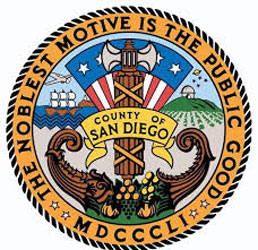New Acquisitions Virtual Exhibit
The San Diego Archaeological Center houses many prehistoric and historic collections from the San Diego County adjacent regions. The Center is equipped with over 5,000 square feet of vault space that allow us to provide long-term curation and care for a wide range of archaeological materials, including artifacts, ecofacts, maps, photographs, and site records. Partnering with local colleges and universities provides a setting for volunteers and students interested in archaeology to gain hands-on experience working with archaeological collections.
How Does the SDAC Acquire New Collections?
Most of the collections that are curated at the Center come to us from Cultural Resource Management (CRM) firms. These CRM firms work with developers around the county to make sure that construction is done using ethical and sustainable methods and that archaeological sites are protected and documented. Once their work is complete, CRM firms curate collections at the Center for long-term preservation and care.
What is in a Collection?
New collections delivered to the Center have many pieces. They must contain a site report, master catalog of curated objects, information about inadvertent discoveries, and other supplemental documentation such as field notes, maps, and photographs.
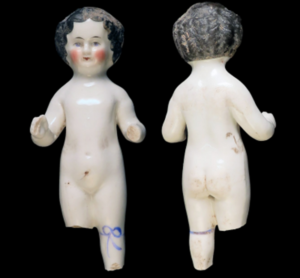
Material Class: Historic
Object Type: Toy, doll
Material: Porcelain
Quantity: 1
Weight: 66.72 grams
SDAC 771 – Delivered March 28th, 2023
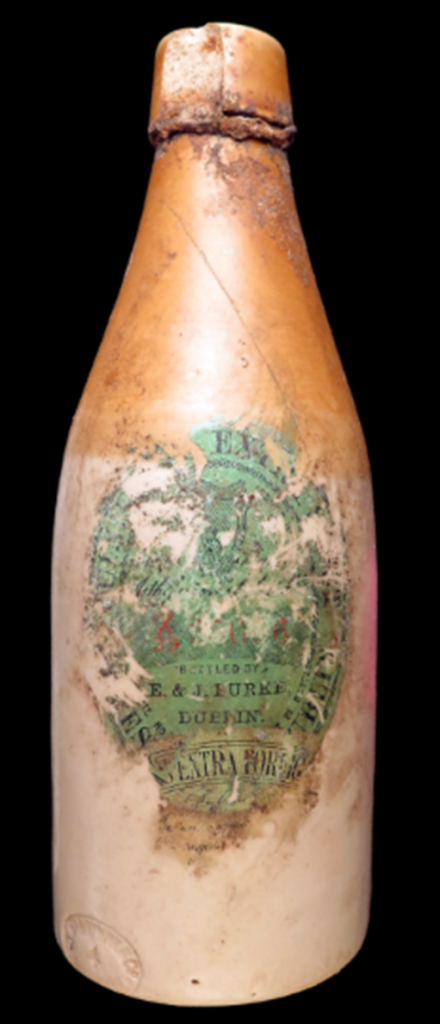
Material Class: Historic
Object Type: Bottle, beer
Material: Stonewear
Quantity: 1
Weight: 789.35 grams
Project Name: East Village Project
Site(s): CA-SDI-22912
USGS Quad Location: Point Loma 7.5’
Year of Excavation: 2018
The project for SDAC 771 took place in the East Village neighborhood of San Diego, California. The project consists of the development of two 31-story buildings for residential, retail spaces, and parking.
The monitoring program for this project took place between 2018 and 2020, and archaeologists and monitors encountered two historic cisterns (or water collection features), one trash privy, and four historic (disturbed) artifacts.
The natural setting of the project for SDAC 771 consists of a “thin horizon of middle to upper Pleistocene-aged, pedogenically-altered, paralic sediments. The sediments of the San Diego Formation were present below a basal pebble-cobble layer of the paralic deposits. Much of the stratigraphy of the San Diego Formation at the project consisted of very fine- to medium-grained sand with variable amounts of coarse-grained, bioclastic sand. Massive and laminated sandstone horizons were punctuated by rubbly, variably concreted, pebble to cobble conglomerates and gravelly sandstones, suggesting a relatively shallow marine, high-energy depositional environment (Wirths and Rugh 2023).” Conroy, p. 15 of project report.
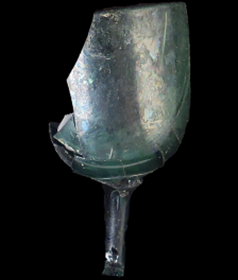
Material Class: Historic
Object Type: Glass, wine
Material: Glass
Quantity: 1
Weight: 45.68 grams
It is known that people living during the Archaic and Late Prehistoric period have used this area. A small wetland developed during the Late Prehistoric period, making this area a marine resource providing abundant food resources. Archaeological evidence suggests that even at the time of European colonization, this wetland was still used by the indigenous groups living here. “The cultures that have been identified in the general vicinity of the project consist of a possible Paleo Indian manifestation of the San Dieguito Complex, the Archaic and Early Milling Stone horizons represented by the La Jolla Complex, and the Late Prehistoric Kumeyaay culture. The area was used for ranching and farming following the Hispanic intrusion into the region and extending into the historic period,” Conroy, p. 15 of project report. Of the features encountered during the project, the only one containing artifactual materials was the historic privy.
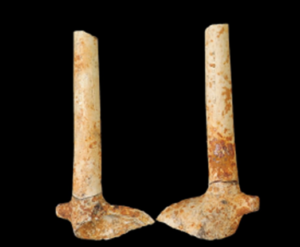
Material Class: Historic
Object Type: Pipe, smoking
Material: Clay
Quantity: 1
Weight: 8.03; 4.29 grams
This privy was first thought to be a well by archaeologists working in the field, but after historic research, it became clear that no wells had been in the area. Instead, after consulting a Sanborn map from 1888, it was labeled as a water closet, made of brick and with a shingle roof. Before modern or indoor plumbing was introduced, it was common for people to use their outdoor privies for not only toilets, but also for trash disposal.
By examining the artifacts removed from the privy, archaeologists suggest that they were deposited by early residents between 1886 and 1910. The artifacts have a mean minimum and maximum range of 1850s-1900s. Records show that between 1886 and 1899, the property was owned by Adolphus Gutstavus Gassen. The property was traded in 1899 and converted into room rentals.
1,833 artifacts were removed from the privy feature, with the majority of artifacts being glass, ceramic, and metal. These items were classified as consumer, household, kitchen, and garment items. Examining the household artifacts alone led archaeologists to infer that the artifacts were used by people with medium to high socioeconomic status, being that many of them “are specialized consumer items such as champagnes, wines, Guinness beer, pumpkin seed oil, olive oil, Worcestershire sauce, and Chow Chow relish,” Conroy, p. 104 of project report.
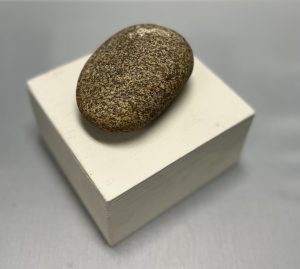
Material Class: Ground stone
Object Type: Mano
Material: Metavolcanic
Quantity: 1
Weight: 326.7 grams
SDAC 762 – Delivered December 21st, 2022
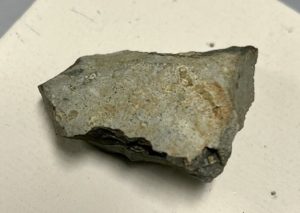
Material Class: Chipped stone
Object Type: Rejuvenation flake
Material: Metavolcanic
Quantity: 1
Weight: 53.6 grams
Project Name: Cultural Resources Inventory and Assessment: Lilac Hills Ranch
Site(s): CA-SDI-18362; -18364; -20436
USGS Quad Location: Bonsall and Pala 7.5’
Year of Excavation: 2007-2012
This project was conducted to provide mitigation measures for the development of the Lilac Hills Ranch community between the years of 2007 and 2012. The proposed development spanned more than 600 acres of land located in Northern San Diego County. Its purpose was to create a mixed use, planned community. This community was to include more than 1,700 dwelling units, neighborhood Town Center, parks and recreation, a senior center, and a school site. Waste recycling and wastewater reclamation facilities were also written into the plan, as well as orchards and other community infrastructure.
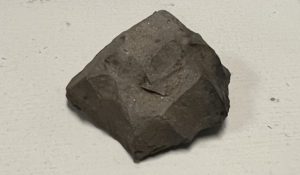
Material Class: Chipped stone
Object Type: Utilized flake
Material: Metavolcanic
Quantity: 1
Weight: 22.4 grams
The natural environment found in the project area is in the foothills and is characterized as Mediterranean hot summer with annual rainfall at 15 inches. Geological features include an area underlain by igneous rock previously mapped as Tonalite of Couser Canyon from the Cretacious period. The granitic bedrock found with these types of features would have provided milling surfaces, and granitic cobbles, or sometimes called manos, used to grind resources.
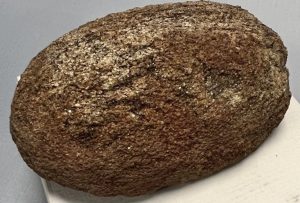
Material Class: Ground stone
Object Type: Mano
Material: Granitic
Quantity: 1
Weight: 416.3 grams
“The project study area supports numerous plant resources that would have attracted native populations. Sage scrub, chaparral, and riparian communities occur within the project area. Plant species noted during the survey include coast live oak, black sage, elderberry, buckwheat, California sagebrush, yucca, coyote bush, scrub oak, laurel sumac, lemonade berry, prickly pear, manzanita, chamise, poison oak, willow, cattail, and sycamore. These and other species common in the vegetation communities are known to have been used by native populations for food, shelter, tools, ceremonial uses, etc. The vegetation communities would have supported a number of animal species also used by native people (see Bean and Shipek 1978; Hedges and Beresford 1978; Sparkman 1908)”. (from p.7 of the project report, Robbins-Wade and Galletti, 2012.)

Seven archaeological sites and two isolated finds were recorded in the project area. While obtaining information for the project, archaeologists were able to identify that one of the sites was mismapped and is not actually located in the project area, and another identified site had been removed during a previous residential development. The five sites that remained include a historic stacked stone rock feature with two milling features near it, a rock shelter/or oven feature, a lithic scatter, and three milling stations.
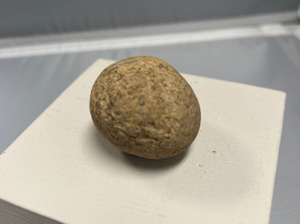
Material Class: Chipped stone
Object Type: Hammerstone
Material: Metavolcanic
Quantity: 1
Weight: 90.0 grams
SDAC 760 – Delivered December 21st, 2022
Project Name: Cultural Resources Monitoring: Creekside Villas, San Diego
Site(s): CA-SDI-9679
USGS Quad Location: Del Mar 7.5’
Year of Excavation: 2014-2015
The CRM company was contracted to provide cultural resource monitoring services for the Creekside Villas project, a development of multi-family residential units and amenities, such as a communal pool and recreation building, covering three acres of land. The project area covers a total of twenty-seven acres of land, and the open space was not included in the project site.
Monitoring was conducted between December 2014 and July 2015, encompassing the previously identified site of SDI-9679. One hearth, 179 artifacts, and 3.8 grams of marine shell were recovered during the project and the original site boundaries were expanded.
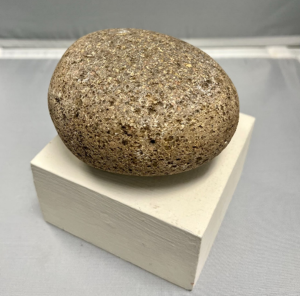
Material Class: Ground stone
Object Type: Mano
Material: Metavolcanic
Quantity: 1
Weight: 937.5 grams
The project environment is within the coastal plains of western San Diego County. The monitoring area was mostly flat with steep slopes on the eastern side. Tertiary Torrey sandstone underlays the project area. Archaeologists working on the project were able to infer that the location would have given indigenous populations water all year long with a water source just north of the project site.
Six habitats were mapped in the project area, including the open space north of the project. They include developed, disturbed habitat; eucalyptus woodland; non-native grassland’ southern maritime chaparral chamise phase; and southern maritime chaparral scrub oak phase (HELIX 2001). The southern maritime chaparral habitats are the only ones that are relevant to the precontact environment, although the non-native grassland might occur in areas that supported native grasses in the past (project report, page 1).
During the monitoring phase, a hearth was uncovered by monitors who used a shovel to remove dirt when they saw what they thought to be fire-affected rock. The hearth was drawn in situ, and soil from the feature was screened so that any cultural material could be identified.
179 artifacts were recovered during the monitoring program at the Creekside Villas project. These include ground stone implements (metate fragments and manos), flaked stone artifacts (debitage, cores, rejuvenation flakes, and a limited variety of flaked stone tools), and hammerstones. In addition, fire-affected rock was noted (one piece was collected), and 3.8 grams of marine shell were collected (project report, page 8).
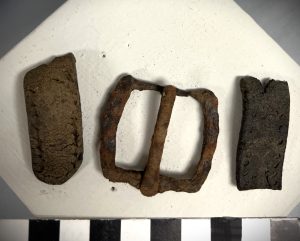
Material Class: Historic
Object Type: Buckle, strap
Material: Metal/glass
Quantity: 1
Weight: 19.36 grams
SDAC 759 – Delivered December 14th, 2022
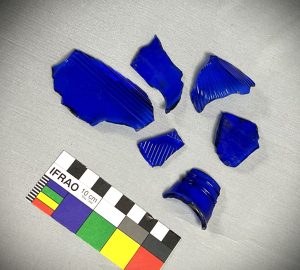
Material Class: Historic
Object Type: Bottle fragment
Material: Glass
Quantity: 6
Weight: 223.97 grams
Project Name: National Historic Preservation Act Section 106 Compliance for the EFRR Parking Expansion and Cielo Azul Trail Project, California
Site(s): CA-SDI-23351
USGS Quad Location: Rancho Santa Fe 7.5’
Year of Excavation: 2022
Time Span of Site: 1898 to present day
The Elfin Forest Recreation Reserve spans 784 acres adjacent to the County of San Diego’s Del Dios Highlands Preserve. It is maintained and operated by the Olivenhain Municipal Water District (OMWD). The purpose of this project proposal is to test for negative impacts to cultural resources in the project areas.
The OMWD is applying for grant funds to expand the parking lot overflow, to accommodate the frequently exceeding parking capacity. Many people enjoying the Reserve have to park on the street and then hike in, which is hazardous and creates traffic for those driving through.
The project site is located in Escondido, within the Rancho Sante Fe USGS quadrangle. The proposed expansion consists of 0.89 acres. To support the implementation of this project, OMWD plans to apply for grant funding. If these future funds come from a federal source, the grantor would serve as the federal lead agency, and the project would be subject to federal regulations, including Section 106 of the National Historic Preservation Act (NHPA) and the National Environmental Policy Act (NEPA). “The proposed project is an undertaking, as defined in Section 106 of the NHPA, and implemented under 36 Code of Federal Regulations Part 800, which requires federal agencies to identify cultural resources within the Area of Potential Effect (APE), to assess impacts to resources found eligible for the National Register of Historic Places (NRHP), and to mitigate adverse effects to eligible resources. To accomplish this, a cultural resources survey was completed in compliance with Section 106,” (p. 5 of project report, Zepeda-Herman).
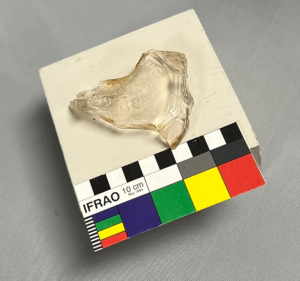
Material Class: Historic
Object Type: Jar, mayonnaise fragment
Material: Glass
Quantity: 1
Weight: 39.32 grams
The CRM firm contracted for this project included survey, excavation, and laboratory methods. The survey resulted in the discovery of one historic trash scatter which was given the site number SDI-23351.
The excavation findings consisted of 222 bottles, 55 jars, 2 cone-top beer cans, 8 tin cans, building materials, furniture, hardware, household glass, kitchen ceramics and glassware, machinery parts, a belt buckle, a metal file, and chicken wire. Of the total artifacts, consumer items constitute 86.49 percent followed by kitchen items at 4.60 percent. Food-related bottles, such as milk, catsup, sauce, vinegar, and spices, represent 16.61 percent of the total consumer items followed by liquor bottles at 13.62 percent (not including the indeterminate category of bottle fragments). The jars and tin cans that are food related represent 10.97 percent of the total consumer artifacts. Consumer items also include household cleaning supplies, ink, polish, lotion, cold cream, and medicines.
No significant or potentially significant prehistoric cultural resources were found during the surveys or excavation phases. Archaeologists determined that, “the artifacts as a composition do not appear to be associated with events that have made a significant contribution to the broad patterns of our history, nor associated with the lives of persons significant in our past, or that embody distinctive characteristics that represent the work of a master, or that possesses high artistic values, or that represents a significant and distinguishable entity whose components may lack individual distinction,” (p. 27 of project report, Zepeda-Herman). The known manufacturer’s marks represented in the resource date between 1895 and the present day; however, most of the represented manufacturing date codes date between 1923 and 1939.
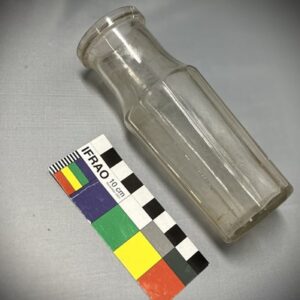
Material Class: Historic
Object Type: Bottle, food
Material: Glass
Quantity: 1
Weight: 207.86 grams
SDAC 758 – Delivered December 1st, 2022
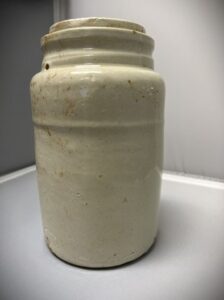
Material Class: Historic
Object Type: Jar, canning
Material: Stoneware, Ceramic
Quantity: 1
Weight: 1075.4 grams
Project Name: The Winslow Mixed Use Building Project
Site(s): CA-SDI-23363
USGS Quad Location: Point Loma 7.5’
Year of Excavation: 2021
Time Span of Site: 1880s-1930s
Two standard size boxes of artifacts came into the Center this past December 2022 from the Winslow Mixed Use Building Project. Five heavily disturbed historic deposits were encountered and recorded during monitoring for this project between December 2020 and July 2021 in the North Park neighborhood of San Diego, California.
The natural setting for SDAC 758 is geologically “mapped as being underlain by the middle Pleistocene-aged Lindavista Formation and Normal Heights mudstone, which is underlain by the Pliocene-aged San Diego Formation (Kennedy 1975). The fine-grained nature of the San Diego Formation sediments supports its deposition in an offshore, normal salinity, marine environment (Wirths 2022). No native flora was identified within the project area at the start of grading. The property was cleared of all development and vegetation. Elevations within the project range from approximately 340 to 350 feet above mean sea level,” (p. 14 of project report.)
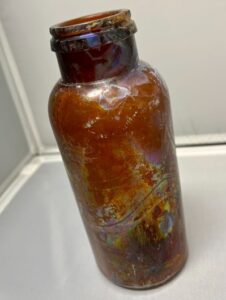
Material Class: Historic
Object Type: Bottle, baby formula
Material: Glass
Quantity: 1
Weight: 388.15 grams
This project had two main research questions: First, for the artifacts identified, under what circumstances was the material discarded and can the deposition be attributed to a specific occupation period or specific occupant? And second, do the artifacts reflect specific information such as gender, age, socioeconomic status, or ethnicity regarding the people who lived or worked in the area?
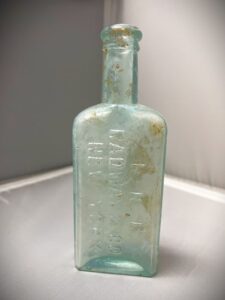
Material Class: Historic
Object Type: Bottle, medicine
Material: Glass
Quantity: 1
Weight: 203.89 grams
While this project encountered only historic artifacts, archaeologists look into all past human occupation, including the prehistory of a specific area. During the prehistoric period in what is now called North Park, there has been evidence of people from the Archaic and Late Prehistoric periods living here. The area was a small wetland that provided marine resources and food. Past research shows that even after European colonization, the indigenous peoples in the region continued to use the resources from the bay and wetland areas. Identified cultures that lived in the area were those of the San Dieguito Complex, the La Jolla Complex, and the Late Prehistoric Kumeyaay.
Over time, open space was replaced by residential and commercial developments in the area, beginning in the 1890s. Archaeologists were able to infer that most of the residents residing in the area over the twentieth century were North American immigrants from other parts of the US, Mexico, and Canada. Other residents immigrated from Brazil, England, Germany, Northern Ireland, Poland, Romania, Russia, Palestine, Syria, and Africa.
Working with the City, the archaeologists working on this project determined that as it was a heavily disturbed site, no testing was required (as the features were disturbed by previous construction and demolition activities). A representative sample of artifacts and diagnostic items was collected from each feature instead.
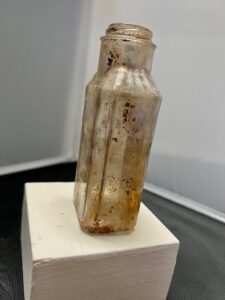
Material Class: Historic
Object Type: Bottle
Material: Glass
Quantity: 1
Weight: 208.1 grams
SDAC 757 – Delivered September 21st, 2022
Project Name: 4th and J Project, San Diego, California
Site(s): P-37-038836
USGS Quad Location: Point Loma 7.5’
Year of Excavation: 2018
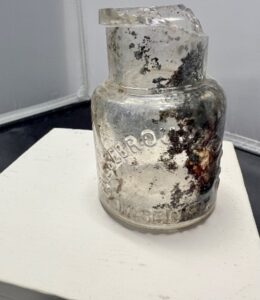
Material Class: Historic
Object Type: Bottle, toiletry fragment
Material: Glass
Quantity: 1
Weight: 69.6 grams
This was a large development project in the Gaslamp District of what is now known as downtown San Diego. It included the demolition of an existing 20,000-square-foot commercial building and new construction of a six-story mixed-use development. That development comprises 168 residential units, amenity spaces, rental office, retail space, and two levels of underground parking on a 0.69-acre rectangular parcel in the Gaslamp District neighborhood.
SDAC 757, or the 4th + J assemblage, confirms documentary sources for the historic block, with an 1895-1912 Euro-American occupation, residents were primarily saloon-workers and prostitutes, and a 1900-1925 Chinese occupation (increasing after 1912), primarily merchants and families. The artifact profile created of the assemblage matches the reference group for urban sites.
The area of the project is designated as Block 120, and by using the 1876 Bird’s Eye View of San Diego and Sanborn Fire Insurance maps from 1887, 1906, and 1921, archaeologists were able to make inferences about the people living in this area during these times.
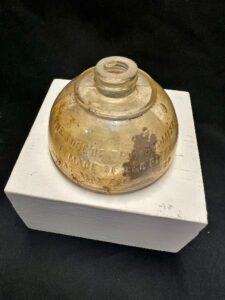
Material Class: Historic
Object Type: Bottle
Material: Glass
Quantity: 1
Weight: 104.7 grams
A total of 349 artifacts were analyzed from this project. The majority were glass (50.7%) and ceramics (25.9%), with shell (11.0%), bone (10.1%), metal (2%), and wood (0.3%) present in lesser quantities. Some of the less common items recovered included a horseshoe, several fragments of an iron, a fragment of a bone toothbrush handle, and several pieces of knob-and-tube electrical hardware. Archaeologists were able to determine that most of the artifacts recovered were manufactured in the United States, and approximately 17% were imported from China and Japan.
One box of artifacts was curated at the San Diego Chinese Historical Museum (SDCHM) and two boxes of artifacts were curated at the SDAC. The SDAC retained a copy of the catalog of items that were curated at the SDCHM for future reference.
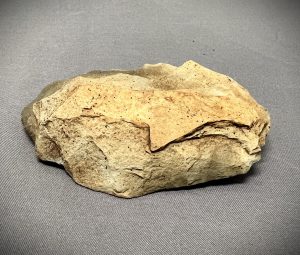
Material Class: Chipped stone
Object Type: Tool
Material: Metavolcanic
Quantity: 1
Weight: 111.26 grams
SDAC 756 – Delivered September 15th, 2022
Project Name: Archaeological Data Recovery Program for the Otay Mesa Business Park Project, San Diego, California
Site(s): SDI-8081; SDI-11799; SDI-17963
USGS Quad Location: Otay Mesa 7.5’
Year of Excavation: 2022
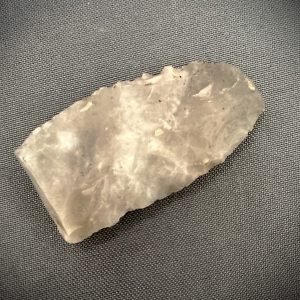
Material Class: Chipped stone
Object Type: Projectile
Point Material: Chert
Quantity: 1
Weight: 4.39 grams
The new acquisition SDAC 756 came into the Center in September 2022. This project was contracted by a developer in the Otay Mesa area of San Diego County, near the Mexican border. In 2006, the CRM firm was contracted to do a cultural resources study for the area, with revisions taking place in 2008, 2009, and 2014 due to reconfigurations of the project. The project area encompassed 121.8 acres of land.
The project area is located near low-lying hills southeast of Otay Valley near the foothills of the San Ysidro Mountains. Elevation varies between 480 and 560 feet above sea level. Geologically, the project area consists of knolls and mesas with small canyons and drainages throughout. A variety of soils were present, including clays and sands that are indicative of flooding; clay mixed with bentonite; and cobbles made of granite, basalt, and quartzite. While the property was vacant during data recovery, it had been used for grazing and farming purposes in the past – introducing cattle grazing grasses and other non-native species of weeds. These factors contributed to a poor surface visibility for the project, requiring careful monitoring of the area during the surveying phases of the project.
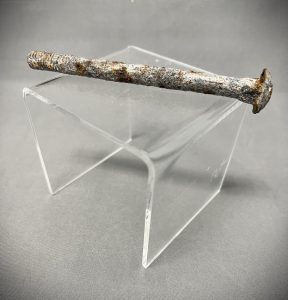
Material Class: Historic
Object Type: Bolt
Material: Metal
Quantity: 1
Weight: 61.9 grams
Three significant sites were identified for mitigation on this project. CA-SDI-8081, CA-SDI-11799, CA-SDI-17963 include two prehistoric sites and one historic site. Time periods connected with these sites are Archaic and Late Prehistoric, and the historic items recovered are from the early 20th century.
Field methodologies included the initial resource study which began in 2006 and was completed in 2009; an updated survey program in 2022 to discern if any major impacts had changed since the 2009 study; a phase I excavation in 2022 focused on the indexing of each site using a grid network; and a phase II data recovery that focused study on locations that had the highest research potential.
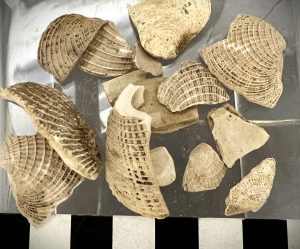
Material Class: Shell, unmodified
Object Type: Bulk
Material: Chione sp.
Quantity: 1
Weight: 29.7 grams
SDAC 755 – Delivered September 15th, 2022
Project Name: Private Drive Data Recovery Program
Site(s): SDI-8081
USGS Quad Location: Otay Mesa 7.5’
Year of Excavation: 2010, 2022
The new acquisition SDAC 755 came into the Center in September 2022. This project was contracted by a landowner in the Otay Mesa area of San Diego County. The proposed project to build many industrial lots, road networks, and other related utilities required a multiphase survey and testing program to be completed by the contracted CRM firm, archaeologists, and Native American monitors.
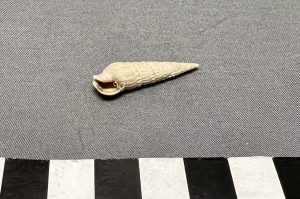
Material Class: Shell, unmodified
Object Type: Whole
Material: Cerithidea californica
Quantity: 1
Weight: 0.8 grams
Four sites were identified during the survey phase with one site being deemed significant with possible research value. The significant site, SDI-8081 included five surface scrapes and the shovel test pit excavations of 52 units. Significant cultural deposits were recovered down to 60 centimeters along with a shell midden deposit that was approximately 889 square meters. Archaeological analysis of the recovered ecofacts and artifacts indicate “that site activities were focused on the procurement, processing, and maintenance of lithic tools. The depth and density of recovered ecofacts indicate that shellfish resources were processed and consumed at the site and represent prolonged occupation.” (Smith, ix)
The significant research potential of the site qualified it for protection under CEQA. As such, all construction work within the upper five feet of soil required monitoring by archaeologists and Native American monitors.
Past projects have also yielded significant site information, and when combined with current analysis, archaeologists had the ability to determine that this was a widely dispersed site used for resource extraction and processing. It was a temporary habitation site first recorded as having a moderate lithic scatter in 1974. The shell midden recovered was thought to have the most research potential, so it was also the most studied feature of the site. The midden was relocated, mapped, and studied in its entirety as part of the mitigation measures required for development to continue.
A total of 176 grams of shell was recovered along with one piece of debitage. Chione sp. accounted for the largest portion of recovered shells at sixty-eight percent of the recovery, with Ostrea lurida being the second largest at fifteen percent. Of the species that were analyzed, most are found in coastal bays and sandy beaches.
Learn more about this collection in our latest New Acquisitions: A Closer Look blog post.
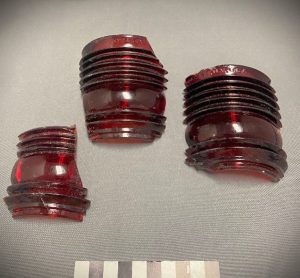
Material Class: Historic
Object Type: Lamp fragment
Material: Glass
Quantity: 15
Weight: 829.7 grams
SDAC 754 – Delivered August 16th, 2022
Project Name: Underground Utility District Project, City of San Diego, California
Site(s): ): P-37-040195; P-37-040200; P-37-040230 (Isolates)
USGS Quad Location: La Jolla7.5’
Year of Excavation: 2019-2021
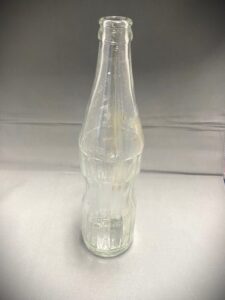
Material Class: Historic
Object Type: Bottle, soda
Material: Glass
Quantity: 1
Weight: 450.4 grams
The new acquisition SDAC 754 came into the Center in August 2022. This project was contracted by the City of San Diego to install underground utilities near the La Jolla area of San Diego. The City of San Diego has a long-term plan to remove overhead utility poles and wires. Archaeologists and Native American monitors worked on this project for 142 days during “earth moving” activities. Three isolated finds were identified and collected by archaeologists during this process.
Many streets nearby this project had similar utilities moved underground in the past. Using this knowledge, the CRM prepared an Archaeological Monitoring Exhibit (AME) after researching the project area. Archaeologists were able to map the streets that had already been excavated and examined, narrowing the monitoring efforts to those that had not yet been disturbed.
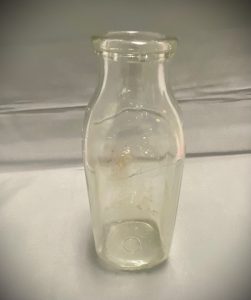
Material Class: Historic
Object Type: Bottle, milk
Material: Glass
Quantity: 1
Weight: 369.4 grams
The project area is a fully developed neighborhood. All native vegetation has been removed. It has been replaced mostly by ornamental landscapes like grass lawns and palm trees. The native plants that would have been present before development include coastal sage scrub (native to San Diego) and riparian like oak trees, poison oak, and roses.
The isolated material collected was historic with no pre-contact material identified. In archaeology, the term isolate refers to one to three artifacts or cultural resources found disassociated from any known site. While they have no known context, they can still be significant and are sometimes collected from the field.
The low density of historic and modern era materials identified do not constitute a significant archaeological deposit. Therefore, the CRM recommended that no further archaeological survey or monitoring of this project area is necessary in the future, as there is a low probability of cultural resource identification or impact.
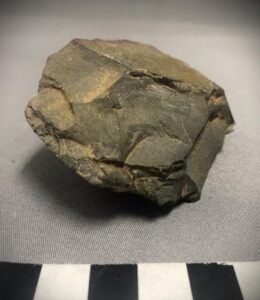
Material Class: Chipped Stone
Object Type: Scraper
Material: Volcanic
Quantity: 1
Weight: 124 grams
SDAC 753 – Delivered August 16th, 2022
Project Name: Underground Utility District Project, City of San Diego, California
Site(s): P-37-040239 (Isolate)
USGS Quad Location: Point Loma 7.5’
Year of Excavation: 2020-2022
The new acquisition SDAC 753 came into the Center in August 2022. This project was contracted by the City of San Diego to install underground utilities near what we now call Old Town, San Diego. Archaeologists and Native American monitors worked on this project for 109 days during “earth moving” activities. One site and five isolated finds were identified by archaeologists during this process.
The only isolated material collected was this Chipped Stone Core (Scraper). In archaeology, the term isolate refers to one to three artifacts or cultural resources found disassociated from their known site. While they have no known context, they can still be significant and are sometimes collected from the field. After evaluation, it was determined that the other isolates found during the project were ineligible for significance under CEQA laws.
CEQA is an important law in California, requiring that all private and public activities be evaluated for the potential to impact the environment, including effects to historical and cultural resources. It defines historical resources as “any object, building, structure, site, area, or place, which is historically significant in the architectural, engineering, scientific, economic, agricultural, educational, social, political, military, or cultural annals of California” (Division I, Public Resources Code, Section 5021.1(b) This law helps to protect cultural resources in San Diego County be requiring mitigation efforts on construction or earth disturbing projects in the state.
The one site that was identified during the project, SDI-23089, consisted of silty loam soils mixed with a historic trash deposit, which could not be associated with a specific residence “and represented common household trash items from the early to mid-twentieth century.” Artifacts recovered were not found significant under CEQA, so nothing was collected from this site. One historic structure was located within the project area, but it was not impacted by any of the work.
The one isolate that was collected and curated for long term preservation is this core scraper tool.
Learn more about this collection in our latest New Acquisitions: A Closer Look blog post.
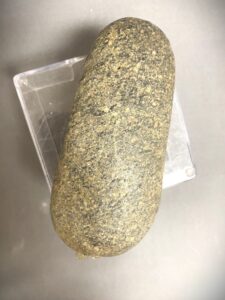
Material Class: Chipped Stone
Object Type: Knapping hammer
Material: Volcanic
Quantity: 1
Weight: 452.46 grams
SDAC 752 – Delivered August 9th, 2022
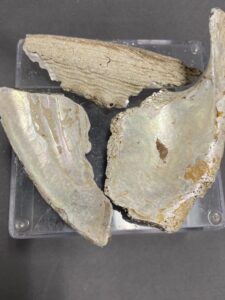
Material Class: Shell, unmodified
Object Type: Fragment
Material: Haliotis
Quantity: Bulk
Weight: 312.80 grams
Project Name: Spindrift Site
Site(s): CA-SDI-39
USGS Quad Location: La Jolla 7.5’
Year of Excavation: 2021-2022
This collection consists of another project from the La Jolla neighborhood in the city of San Diego encompassing the Spindrift Site, which is well known to archaeologists as a large prehistoric occupation site. We received a project from this same neighborhood from an excavation in 2020, which you can read about below in the post for SDAC 750.
Archaeologists look to all past projects before they begin their work at a well-documented site. This site, the Spindrift Site, has been previously recorded as a prehistoric village that dates from the Early Archaic La Jolla Complex through the Late Prehistoric Period.
Another private residence within this site boundary was looking to do a remodel, and because of the significance of the Spindrift Site, archaeologists were onsite during all phases including the soil disturbance. Kumeyaay Native American monitors from Red Tail Environmental were also onsite for all phases.
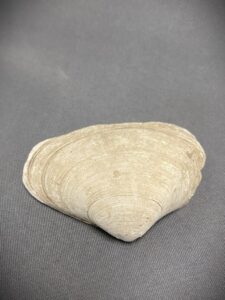
Material Class: Shell, modified
Object Type: Scraper
Material: Tivela
Quantity: 1
Weight: 14.41 grams
During the testing phase of this project, it was determined that the soil in the project boundary was heavily disturbed in the past, likely before and during the construction of the original property. The area of the property where the project occurred was not thought to have archaeological value or significance because of its lacking provenience. Context was lost even further when the disturbance was mixed with fill soil. Tizon Brownware ceramics were recovered in this phase of the project, dating this portion of the site to at least Late Prehistoric. Other than the partial dating, archaeologists did not expect to advance research for this site once they determined that it was disturbed and lacking provenience.

Material Class: Shell, modified
Object Type: Scraper
Material: Tivela
Quantity: 1
Weight: 14.41 grams
During the monitoring program, 1,353 cultural resources were collected, and forty-seven were recovered from the testing phase. The range of material classes and types of artifacts found in the SDI-39 boundaries imply that some of the site activities included deep-water fishing; use and creation of fishing gear, basketry, projectile points and shafts, and shell beads; use and potential manufacture of ceramics and bone tools; and possible trade with other communities.
Learn more about this collection in our latest New Acquisitions: A Closer Look blog post.
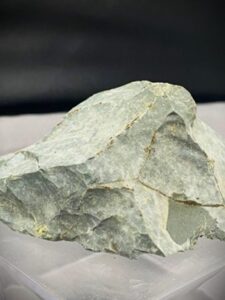
Material Class: Chipped Stone
Object Type: SEUT
Material: Metavolcanic
Quantity: 1
Weight: 174.3 grams
SDAC 751 – Delivered June 16th, 2022
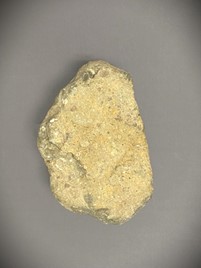
Material Class: Stone, other
Object Type: Manuport
Material: Metavolcanic
Quantity: 1
Weight: 958.3 grams
Project Name: Cultural Resources Data Recovery Report for CA-SDI-10070 and CA-SDI-10071, Otay Mesa, California
Site(s): CA-SDI-10070 and CA-SDI-10071
USGS Quad Location: Otay Mesa 7.5’
Year of Excavation: 2021
Previous work conducted in this project area had identified that these sites were significant, and therefore, mitigation, such as data recovery, was required for the development to move forward. An initial surface collection of SDI-10070 produced more than 270 cultural resources, which was a significant find and led to an excavation. The excavation of two 1×1 meter units recovered more than 370 cultural resources and ecofacts. A piece of shell, weighing 0.6 grams, was sent off for AMS radiocarbon analysis and provided a date of 8,401-8,320 years before present.
Testing of SDI-10071 recovered 225 cultural resources, including one shell sample that dated the site to 7,200 years before present. As a result of this date, the number of objects found in each unit, and the site’s potential to contribute data to the archaeological record of San Diego, this site was identified as a significant cultural resource. The recovery of scraping, battering, and milling tools from these sites help to identify them as temporary special purpose campsites, possibly used to process wood, plant, and animal resources.
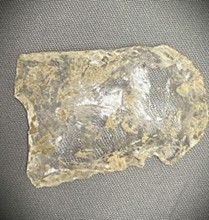
Material Class: Chipped stone
Object Type: Biface
Material: Quartz
Quantity: 1
Weight: 8.5 grams
The results from data recovery of the 2021 project suggest that these sites were located on knolls about 1,000 feet apart from the other. With seasonal plants and fresh water in a nearby canyon, these locations would have been ideal for occupants during the Early and Middle Holocene.
After comparing the new data with past data from these sites, archaeologists can infer that SDI-10070 and SDI-10071 were special use, short-term habitation sites used on a seasonal basis for hundreds of years to process seasonal resources. To determine exactly what these resources were, a residue analysis is needed. Manos and metates recovered would have been used to process vegetal materials, while SEUTs (or Steep-Edged Unifacial Tools) suggest scraping of plant products, preparation of small animal skins, and wood working.
Learn more about this collection in our blog New Acquisitions: A Closer Look.
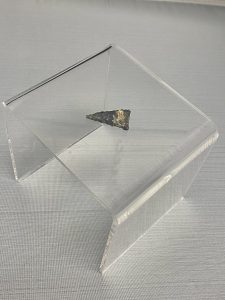
Material Class: Chipped Stone
Object Type: Projectile point
Material: Obsidian
Quantity: 1
Weight: .95 grams
SDAC 750 – Delivered February 14th, 2022
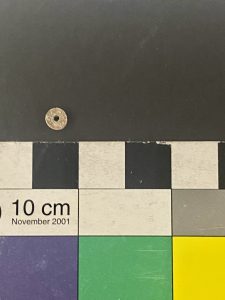
Material Class: Shell, modified
Object Type: Disc bead
Material: Olivella sp.
Quantity: 1
Weight: .03 grams
Project Name: Spindrift Site
Site(s): SDI-39
USGS Quad Location: La Jolla 7.5’
Year of Excavation: 2020
This project took place in a La Jolla neighborhood of the city of San Diego, California. This area of La Jolla is a large prehistoric occupation site known as the Spindrift Site (SDI-39/W-1). The Center has many collections and cultural resources that have been saved during the developments in this booming, populated area.
This site has been previously recorded as a prehistoric village spanning from the Early Archaic La Jolla Complex through the Late Prehistoric Period. Previous excavations and surveys of this site have revealed human remains in the vicinity of the current project, and this site has been determined to be significant in accordance with California Environmental Quality Act (CEQA) and City of San Diego criteria. With advice from the CRM firm and after consultation with the City of San Diego, the owner of the project decided to revise their development plan to avoid any impacts to cultural resources associated with this site. No significant cultural deposits were identified within the impact area.
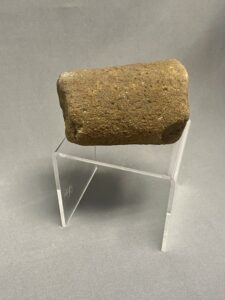
Material Class: Ground stone
Object Type: Pestle
Material: Sandstone
Quantity: 1
Weight: 493.41 grams
Kumeyaay Native American monitors from Red Tail Environmental were present during all work due to the sensitivity of this site. Recovered artifacts include bone tools, ground stone, lithic tools, otoliths, projectile points, Tizon Brown Ware prehistoric ceramics, shell beads, and vertebrate faunal remains.
No mitigation measures were necessary because no significant cultural deposits were going to be affected by construction. Therefore, the development permit was approved by the City with a condition that all cultivated soil required archaeological screening and all cultural artifacts were to be collected and curated or repatriated.
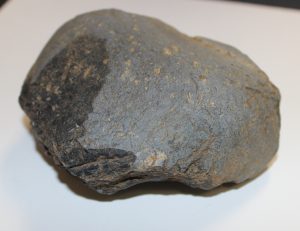
Material Class: Chipped Stone
Object Type: Angular Hammer
Quantity: 1
Weight: 449.4 grams
SDAC 749 – Delivered October 21st, 2021
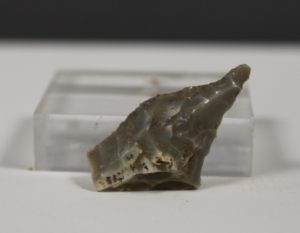
Material Class: Chipped Stone
Object Type: Drill
Material: Chert
Quantity: 1
Weight: 2 grams
Project Name: Results Of The Mitigation Monitoring Program For The Sequoia 5 Project
Site(s): SDI-11571
USGS Quad Location: La Jolla 7.5’
Year of Excavation: 2020
The Sequoia 5 Project took place during the removal of two residential buildings to make room for the construction of five new residential units. This site had been previously excavated and recorded in the 1920s prior to the current residential development. The site was recorded by archaeologist Malcom Rogers, and he described it as an “Early Archaic Period intermittent camp along the estuary margin containing a scattered and discontinuous area of prehistoric occupation.” For the new project, after sampling the grading footprint, it was determined that the data being collected was redundant and the project was given the green light to move forward. Because this site was a significant cultural site, Kumeyaay Native American representatives from Jamul were present during all field operations. 576 prehistoric artifacts were recorded during the excavation, and by examining the lithic assemblage, archaeologists were able to determine that this site likely belonged to the Archaic La Jolla Complex between 2,000 and 8,000 years before the present.
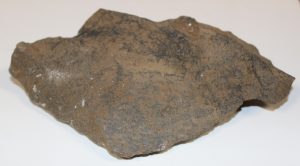
Material Class: Chipped Stone
Object Type: Flake tool
Material: Volcanic
Quantity: 1
Weight: 350.8 grams
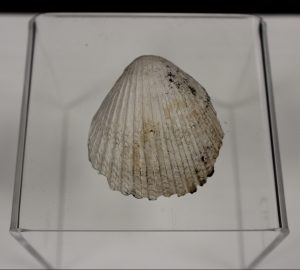
Material Class: Shell, unmodified
Object Type: Fragment
Quantity: 5
Weight: 17.4 grams
Photos by Collections Technician Vanessa Chappins
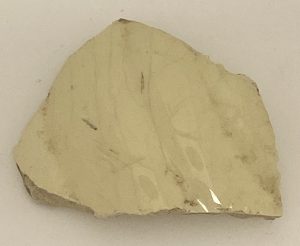
Material Class: Historic
Object Type: Ceramic fragment
Material: Porcelain
Quantity: 1
Weight: 39.3 grams
SDAC 748 – Delivered September 28th, 2021
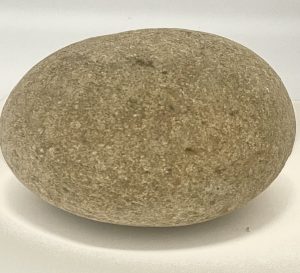
Material Class: Ground stone
Object Type: Mano
Material: Granitic
Quantity: 1
Weight: 909.1 grams
Project Name: Cultural Resources Monitoring Report for the California Crossings Project
Site(s): SDI-12337 or P-37-012337-2021
USGS Quad Location: Otay Mesa 7.5’
Year of Excavation: 2021
This project encompasses site SDI-12337, which was first recorded in 1989. It consists of sparse lithic scatter ranging over 700 acres where debitage, stone tools, and cores have been found. The project monitoring lasted for thirty-two days and a total of thirty-eight prehistoric cultural resources were recovered during this period. Two historic artifacts, an amber glass shard and piece of ceramic, were also recovered. A metal pulley system was found and recorded, but not collected. Of the thirty-eight prehistoric resources collected, there was one mano, twenty-three pieces of debitage, two flakes, ten utilized tools, and two cores. Findings from monitoring of the project resulted in no significant effect on cultural resources in the area.

Material Class: Chipped stone
Object Type: Flake
Material: Chalcedony
Quantity: 1
Weight: 113.4 grams
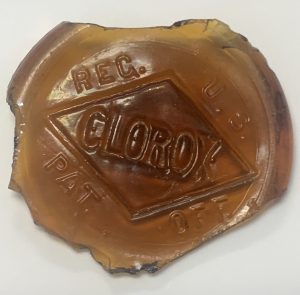
Material Class: Historic
Object Type: Bottle, cleaner fragment
Material: Glass (Amber)
Quantity: 1
Weight: 92.1 grams
Comments: “CLOROX”; amber bottle base fragment
SDAC 747 – Delivered September 8th, 2021

Material Class: Historic
Object Type: Plate fragment
Material: Transferware
Quantity: 3
Weight: 13.3 grams
Project Name: Cultural Resource Monitoring for Sewer and AC Water Group
Site(s): SDI-22522; P-37-038123
USGS Quad Location: Point Loma 7.5’
Year of Excavation: 2019
This project consisted of monitoring during the replacement of existing water and sewage mainlines with new lines. During the project, historic debris was observed, and diagnostic resources were collected. The soil was heavily disturbed, which led archaeologists and Native American monitors to determine that there was a lack of significance at this site and the project could move forward.
The isolate site, P-37-038123 contained one amber glass bottle, possibly pharmaceutical in nature, with an Owens-Illinois makers mark dating the bottle to between 1929 and 1954. The second is a colorless glass bottle from the same maker.
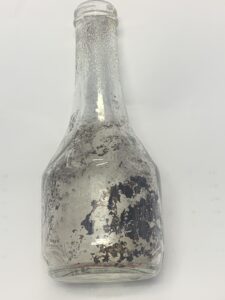
Material Class: Historic
Object Type: Bottle, juice
Material: Glass
Quantity: 1
Weight: 200.7 grams
SDI-22522 had many glass bottles and fragments, ranging from pill bottles to condiment bottles, and even a glass deodorant bottle was collected. The bottles date from 1903 to present day, with a heavy concentration between 1930 and 1937. A reasonable amount of ceramic tableware was also collected, but unfortunately, none of the pieces had diagnostic maker’s marks.
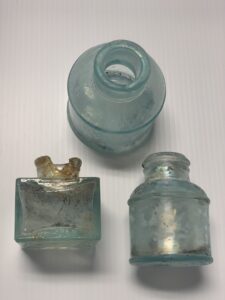
Material Class: Historic
Object Type: Bottle, ink
Material: Glass (Aqua)
Quantity: 3
Weight: 337.4 grams
SDAC 746 – Delivered September 8th, 2021
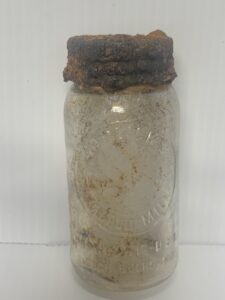
Material Class: Historic
Object Type: Bottle, malted milk
Material: Glass & Metal
Quantity: 1
Weight: 70.9 grams
Comments: “Horick’s / Malted Milk / Racine-Wis-USA/ Slouch Bucks”
Project Name: Cultural Resource Monitoring Report for 15th and Broadway
Site(s): P-37-021194
USGS Quad Location: Point Loma 7.5’
Year of Excavation: 2020
This project was conducted to monitor the demolition and excavation of this site to make way for construction of a parking lot and residential spaces. Two previous archaeological investigations have taken place near this site. One of the structures that used to be at this site was an early 1900s automotive repair shop and dealership named the J.F McKnight building. It existed from 1918 to 1944 until it became the El Cortez Pontiac Company, followed by the Kasey Pontiac Company, and then the American Business College.

Material Class: Historic
Object Type: Bottle, condiment
Material: Glass (Green)
Quantity: 1
Weight: 119.1 grams
Comments: Mustard condiment bottle; “LOUIT”
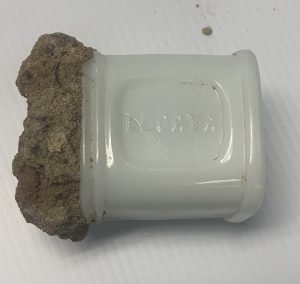
Material Class: Historic
Object Type: Jar, cosmetic
Material: Milk Glass
Quantity: 1
Weight: 227.1 grams
Comments: “ELCAYA / JAMES C. CRANE, NEW YORK”
Archaeological resources found during excavation were recorded, and diagnostic artifacts were collected for analysis before being permanently curated at the SDAC. Diagnostic artifacts range from 1870 to 1920. The artifacts consist of mostly alcohol and liquor bottles, personal hygiene items, and tableware. Additionally, there were hardware, construction, and home décor items. Two sherds of Chinese Brown Glazed Stoneware and fragments of a celadon bowl were observed as well as precontact lithic materials, which indicate the presence of Chinese and Native American communities within this site.
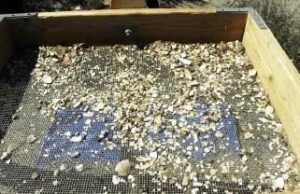
SDAC 745 – Delivered June 30th, 2021
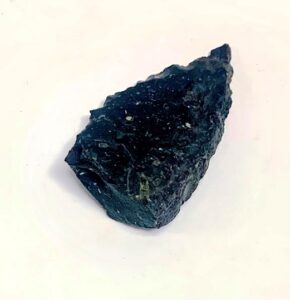
Material Class: Chipped Stone
Object Type: Modified flake
Material: Metavolcanic
Quantity: 1
Weight: 60.1 grams
Project Name: CALTRANS R-75 Relinquishment Project
Site(s): CA-SDI-59; – 14414
USGS Quad Location: Point Loma 7.5’
Year of Excavation: 2021
This project included test excavations at four sites that had been previously recorded to determine significance of the sites. SDI-59 was originally recorded as a prehistoric camp site located near what we now call the Silver Strand. SDI-14414 was recorded as a likely prehistoric shell scatter, but no cultural resources had been observed there previously. Archaeologists observed that both sites have been heavily disturbed with modern debris (plastic, glass, and asphalt fragments).
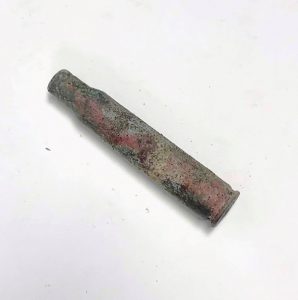
Material Class: Historic
Object Type: Cartridge casing
Material: Metal
Quantity: 1
Weight: 14.4 grams
During this project, a total of seven objects were collected from these two sites, including three lithic cultural resources, a historic artifact, and shards of mammal and fish bone.

Material Class: Chipped Stone
Object Type: Flake
Material: Metavolcanic
Quantity: 1
Weight: 42.7 grams
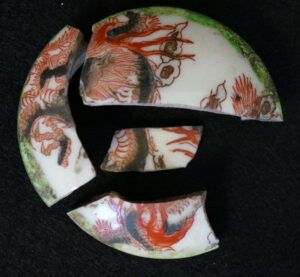
Material Class: Historic
Object Type: Plate or bowl
Material: Ceramic
Quantity: 4
Weight: 30.6 grams
SDAC 744 – Delivered April 6th, 2021
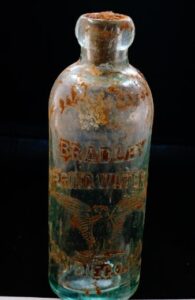
Material Class: Historic
Object Type: Bottle, water
Material: Glass
Quantity: 1
Weight: 420.5 grams
Project Name: The Kettner Project
Site(s): P-37-039071
USGS Quad Location: Point Loma 7.5’
Year of Excavation: 2019
This project was conducted in what is now known as Little Italy, and according to historic map review, there were five historic residential occupations identified in this project area. All five residences were demolished or reconstructed between the 1910s and 1940s and replaced by commercial and industrial developments. These residences were single-story and multi-family, likely constructed in the 1890s. Historic records indicate that the residences were occupied by many tenants from 1892 to 1909 including an attorney, a plasterer, a widow, a teamster, and many laborers. From 1913 to 1926, there were a foreman, a phone operator, and military members. More than 3,000 historic artifacts were collected from this site, glass and ceramic being the most common materials.
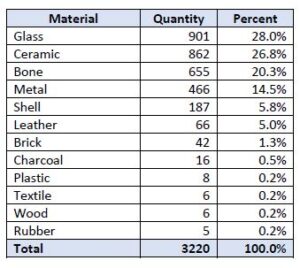
The chart above represents the types and quantity of materials collected during excavation.
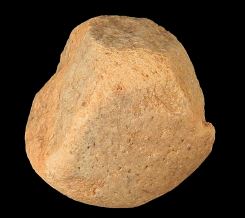
Material Class: Chipped stone
Object Type: Hammerstone
Material: Granite
Quantity: 1
Weight: 249.7 grams
SDAC 743 – Delivered January 28th, 2021
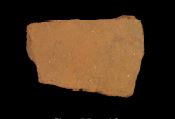
Material Class: Ceramic
Object Type: Body sherd
Material: Tizon Brownware
Quantity: 1
Weight: 11.6 grams
Project Name: The Miller Road Project
Site(s): CA-SDI-278
USGS Quad Location: Valley Center 7.5’
Year of Excavation: 2014
This project is being developed for commercial and retail use in the Valley Center area of San Diego County. During the monitoring for this project, fourteen cultural resources were recovered from disturbed earth, including debitage, a hammerstone, manos, metate fragments, and ceramic fragments. Prehistoric use at this site was determined to be sporadic, mostly for temporary food processing and resource collection. Since there is limited water access near this site and minimal cultural resources were collected, it is doubtful that it was used much for food or lithic procurement.
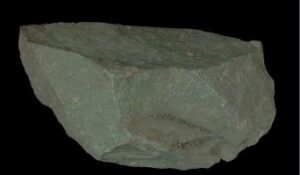
Material Class: Chipped stone
Object Type: Tool
Material: Volcanic
Quantity: 1
Weight: 153.3 grams
SDAC 742 – Delivered January 20th, 2021
Project Name: Bush Residence
Site(s): CA-SDI-39
USGS Quad Location: La Jolla 7.5’
Year of Excavation: 2020
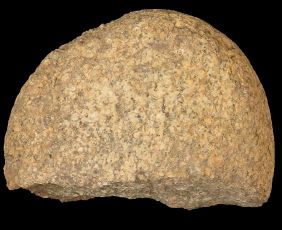
Material Class: Ground stone
Object Type: Mano
Material: Granite
Quantity: 1
Weight: 461.9 grams
This project consisted of excavation and recovery of archaeological materials during a residence modification. CA-SDI-39 is a large site that has been studied and excavated many times throughout the 20th and 21st centuries. It is called the Spindrift Site and has been determined significant according to CEQA and the City of San Diego. This site has been previously recorded as a prehistoric occupation complex spanning the Early Archaic to the Late Prehistoric cultural periods. This site is closely associated with marine resource that are present in the La Jolla bay area. Cultural materials recovered included cores, flake tools, manos, a pestle, debitage, prehistoric ceramic, faunal bone, marine shell, fire affected rock (FAR), brick fragments, nails, bottles and containers, a cosmetic jar, marble, tableware fragments, and saw-cut faunal bone.
The range of recovered artifacts from the Bush Residence Project allows archaeologists to identify this site as a primarily Late Period habitation site occupied circa 900 to 300 BCE.
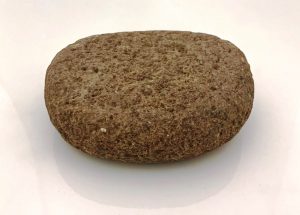
Material Class: Ground stone
Object Type: Mano
Material: Granite
Quantity: 1
Weight: 587.9 grams
SDAC 741 – Delivered December 17th, 2020
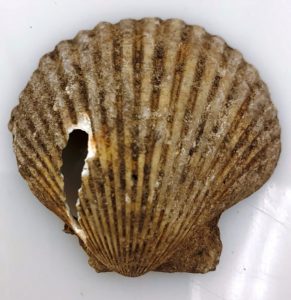
Material Class: Shell, unmodified
Object Type: Fragment
Material: Pecten
Quantity: 1
Weight: 9.3 grams
Project Name: The SDG&E Tie Line Wood to Steel Street Project
Site(s): CA-SDI-9976
USGS Quad Location: Otay Mesa 7.5’
Year of Excavation: 2019
This project consisted of excavation and recovery of archaeological materials in quantities that are sufficient enough to mitigate the impacts of the project on the integrity of the site. Excavation and recovery revealed that the sediments were heavily disturbed but that cultural resources and materials were sparse. Three radiocarbon dates indicate that the area is older than previously had been expected, dating back to 7,998 to 7,407 BCE. Even though this is a very old site, the lack of soil changes and cultural materials recovered here indicates that the area is not a significant. Anything that had potential significance was properly retrieved, analyzed, and used for scientific research.
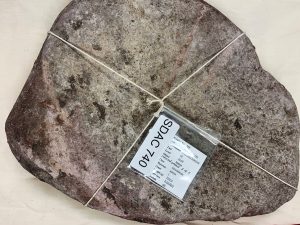
Material Class: Ground stone
Object Type: Metate
Material: Granite
Quantity: 1
Weight: 7937.9 grams
SDAC 740 – Delivered October 28th, 2020
Project Name: Lonestar Site
Site(s): CA-SDI-10299
USGS Quad Location: Otay Mesa 7.5’
Year of Excavation: 2019-2020
Site Description: Middle Holocene milling tools found in Otay Mesa during monitoring program.
Archaeologists think it is likely that this is a small, localized single deposit, disturbed habitation site dating to approximately 5,500 years ago with milling tools, steep edge unifacial tools, battered implements, bifaces (points and knives), flake tools, cores, unifacial rejuvenation flakes, debitage, and a small amount of shell. The presence of these cultural resources indicates this site was used for a special purpose, likely short-term habitation used on a seasonal basis to acquire, process, and utilize seasonal resources.
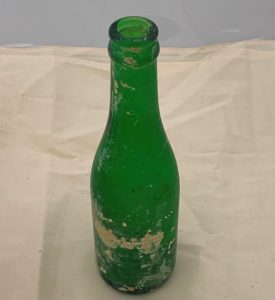
Material Class: Historic
Object Type: Bottle
Material: Glass
Quantity: 1
Weight: 333.8 grams
SDAC 739 – Delivered September 29th, 2020
Project Name: Third and A Street Project
Site(s): CA-SDI-22913
USGS Quad Location: Point Loma 7.5’
Year of Excavation: 2019
Site Description: Historic site consisting of early 1900s house foundation and isolated artifact recovery.
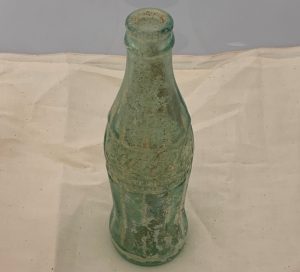
Material Class: Historic
Object Type: Bottle
Material: Glass
Quantity: 1
Weight: 398.91 grams
Archaeologists conducted mitigation monitoring at this site and one historic brick house foundation feature and four isolated cultural resources were indentified, recovered, and returned to the lab for processing. They were able to associate this site with a historic residence situated here using Sanborn maps from 1906, 1921, and 1950. The portion of the foundation identified represents an expansion of the home between 1906 and 1921. Using historic aerial photographs, it was determined that the residence was demolished sometime between the years 1950-1953.
A glass cosmetic jar, decorative porcelain jar, and two soda bottles were recovered from this site. The cosmetic and decorative jars are likely from 1900-1920, representing household and individual residents. The two soda bottles, one Coca-Cola bottle and one 7-Up bottle were manufactured in 1956 and 1957. These items were recovered from the perimeter of the site and likely represent trash disposal by employees or patrons of nearby businesses.

Material Class: Chipped Stone
Object Type: Debitage
Material: Fine-grained Metavolcanic
Quantity: 1
Weight: 103.58 grams
SDAC 738 – Delivered August 27th, 2020
Project Name: Avion Project
Site(s): CA-SDI-18428; -18429
USGS Quad Location: Poway 7.5’
Year of Excavation: 2019
Three hundred sixty-one cultural resources were recovered from the test excavations at CA-SDI-18428: 359 flakes (pieces of stone removed from a core) and 2 tools. Archaeologists on the project were able to conclude that the limited range of materials recovered indicates that tool production was not taking place on-site, but rather it was a place where final shaping and re-sharpening happened.
Thirteen cultural resources were recovered at CA-SDI-18429, all debitage (waste or byproduct of stone tool production). The material recovered was predominantly fine-grained metavolcanic. No tools, cores, or milling implements were found. Archaeologists concluded that this site was most probably used as a single use episode of locally available material produced for core preparation or tool re-sharpening.
Funded in part by the City of San Diego Commission for Arts and Culture and the County of San Diego

